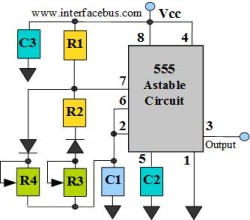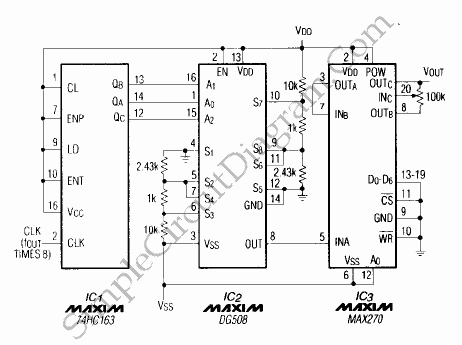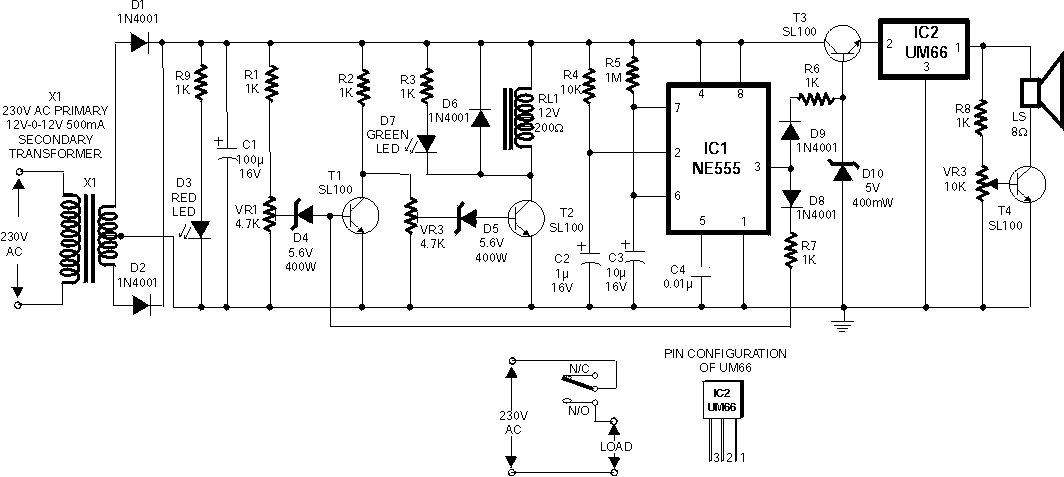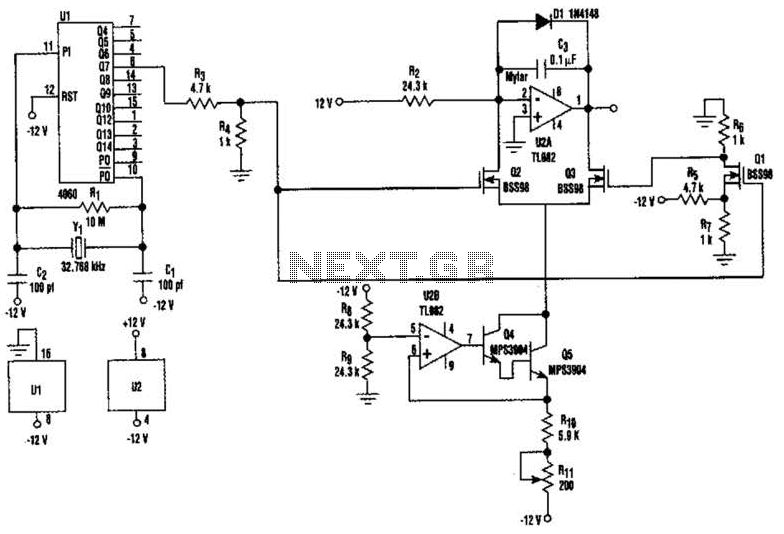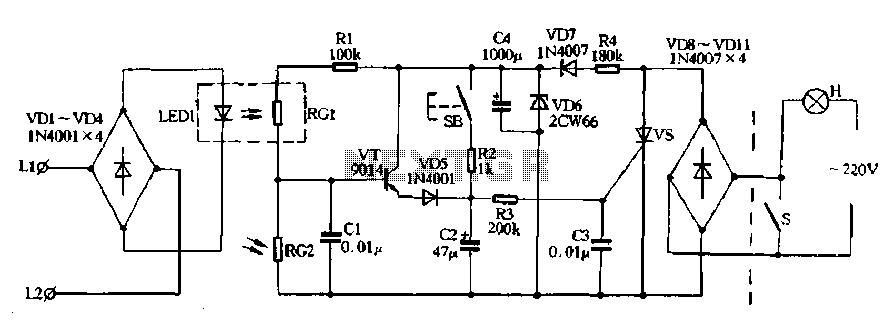
Pulse Generator And Signal TracerCircuit
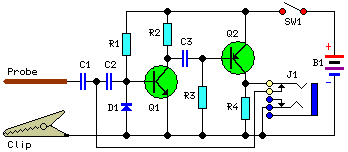
This simple circuit generates narrow pulses at a frequency of approximately 700-800 Hz. The pulses, which contain harmonics extending into the MHz range, can be injected into audio or radio-frequency stages of amplifiers and receivers for testing purposes. A high-pitched tone will be audible from the speaker of the device under test when functioning correctly. The clip must be connected to the ground of the device under test, with the probe touching various stages of the circuit, starting from the last stage and moving towards the first. When the tone ceases, the defective stage has been identified. By connecting an earclip or headphone to J1, the circuit automatically transitions into a two-stage amplifier, allowing any audio signal from the device under test, captured by the probe, to be heard through the headphones. Testing should proceed in reverse order, beginning from the first stage and moving down to the last stage. When no sound is heard, the defective stage has been located. Q1 and Q2 form a complementary astable multivibrator, with the operating frequency primarily determined by the values of R3, C2, and C3. Output pulses are derived from the collector of Q2 and delivered to the probe through decoupling capacitor C1. Diode D1 shapes the output waveform symmetrically. If an earclip or headphone jack is inserted into J1, the connection between the collector of Q2 and capacitors C1 and C2 is interrupted by a switch within J1, converting the circuit into a two-stage amplifier. For testing valve-operated devices, C1 must be rated for 630V. For low-voltage transistor devices, the voltage rating of C1 can be reduced to 63V or 100V. If a longer wire is used instead of a short probe to connect to the device under test, a small ceramic capacitor (470 to 1000 pF) should be placed in parallel with D1 to prevent unwanted RF oscillations. The current draw in Pulse-Generator mode is approximately 60 µA and 1.2 mA in Signal-Tracer mode. Consequently, switch SW1 can be omitted, provided that the earclip or headphones are disconnected when the circuit is not in use. J1 is a stereo switched jack socket configured to create a series connection of the two earpieces of a stereo headphone. This configuration increases the circuit's load impedance, thereby enhancing sensitivity. Therefore, the higher the load impedance, the more sensitive the Signal-Tracer becomes. Common 32-ohm impedance mini-headphones, suitable for walkman sets, will function effectively.
The circuit operates as a versatile testing tool for audio and RF applications, leveraging a complementary astable multivibrator configuration that allows for adjustable frequency output. The choice of components, particularly resistors R3 and capacitors C2 and C3, plays a critical role in establishing the desired pulse frequency, while the output waveform is refined by diode D1 for symmetry. The dual functionality of the circuit, transitioning from pulse generation to audio amplification, is facilitated by the incorporation of J1, which not only serves as a connection point for headphones but also integrates a switching mechanism that alters the circuit's operation based on the presence of a load.
For optimal performance, careful consideration of component ratings is essential, particularly when interfacing with high-voltage devices. The current consumption characteristics indicate efficient operation in both modes, allowing users to maintain prolonged testing sessions without significant power drain. The inclusion of a small ceramic capacitor when using longer leads mitigates potential RF interference, ensuring signal integrity during testing. The design's adaptability to various load impedances enhances its usability across different applications, making it suitable for a wide range of audio and RF testing scenarios. Overall, this circuit serves as a valuable asset for engineers and technicians engaged in the testing and troubleshooting of electronic devices.This simple circuit generates narrow pulses at about 700-800Hz frequency. The pulses, containing harmonics up to the MHz region, can be injected into audio or radio-frequency stages of amplifiers, receivers and the like for testing purposes. A high-pitched tone can be heard from the speaker of the device under test when all is working properly.
Th e clip must be connected to the ground of the device under test, touching with the probe the different stages of the circuit, starting from the last stage and going up towards the first. When the tone is no longer heard, the defective stage has been found. Connecting an earclip or headphone to J1, the circuit will automatically change into a two-stage amplifier and any audio signal coming from the device under test and picked-up by the probe will be heard through the headphones.
The testing of a circuit should be made in the reverse manner, i. e. starting from the first stage and going down until the last stage. When nothing is heard, the defective stage has been found. Q1 & Q2 form a complementary astable multivibrator, whose operating frequency is set mainly by R3, C2 & C3 values. Output pulses are taken at Q2 Collector and applied to the probe by means of decoupling capacitor C1.
D1 provides a symmetrical shape for the output waveform. If an earclip or headphone jack is plugged into J1, the connection from Q2 Collector and C1 - C2 is broken by the switch incorporated into J1: in this case the circuit becomes a two-stage amplifier. If you intend to use the circuit to test valve operated devices C1 must be a 630V type. Working with low voltage supply transistor devices the voltage of C1 can be lowered to 63 or 100V. If instead of a short probe, you intend to connect the circuit to the device under test by means of a piece of wire longer than a few centimeters, a small ceramic capacitor (470 to 1000pF) should be added in parallel to D1 to prevent unwanted RF oscillation.
Current drawing when in Pulse-Generator mode is about 60 µA and 1. 2mA when in Signal-Tracer mode operation. Therefore SW1 can be omitted, provided that the earclip or headphones are unplugged when the circuit is unused. J1 is a stereo switched jack socket wired to obtain a series connection of the two earpieces forming a stereo headphone.
In this manner the circuit is loaded with a higher impedance and sensitivity will be improved. Therefore, the higher the load impedance the more sensitive the Signal-Tracer. In any case, common 32 Ohm impedance mini-headphones suitable for walkman sets will work fine. 🔗 External reference
The circuit operates as a versatile testing tool for audio and RF applications, leveraging a complementary astable multivibrator configuration that allows for adjustable frequency output. The choice of components, particularly resistors R3 and capacitors C2 and C3, plays a critical role in establishing the desired pulse frequency, while the output waveform is refined by diode D1 for symmetry. The dual functionality of the circuit, transitioning from pulse generation to audio amplification, is facilitated by the incorporation of J1, which not only serves as a connection point for headphones but also integrates a switching mechanism that alters the circuit's operation based on the presence of a load.
For optimal performance, careful consideration of component ratings is essential, particularly when interfacing with high-voltage devices. The current consumption characteristics indicate efficient operation in both modes, allowing users to maintain prolonged testing sessions without significant power drain. The inclusion of a small ceramic capacitor when using longer leads mitigates potential RF interference, ensuring signal integrity during testing. The design's adaptability to various load impedances enhances its usability across different applications, making it suitable for a wide range of audio and RF testing scenarios. Overall, this circuit serves as a valuable asset for engineers and technicians engaged in the testing and troubleshooting of electronic devices.This simple circuit generates narrow pulses at about 700-800Hz frequency. The pulses, containing harmonics up to the MHz region, can be injected into audio or radio-frequency stages of amplifiers, receivers and the like for testing purposes. A high-pitched tone can be heard from the speaker of the device under test when all is working properly.
Th e clip must be connected to the ground of the device under test, touching with the probe the different stages of the circuit, starting from the last stage and going up towards the first. When the tone is no longer heard, the defective stage has been found. Connecting an earclip or headphone to J1, the circuit will automatically change into a two-stage amplifier and any audio signal coming from the device under test and picked-up by the probe will be heard through the headphones.
The testing of a circuit should be made in the reverse manner, i. e. starting from the first stage and going down until the last stage. When nothing is heard, the defective stage has been found. Q1 & Q2 form a complementary astable multivibrator, whose operating frequency is set mainly by R3, C2 & C3 values. Output pulses are taken at Q2 Collector and applied to the probe by means of decoupling capacitor C1.
D1 provides a symmetrical shape for the output waveform. If an earclip or headphone jack is plugged into J1, the connection from Q2 Collector and C1 - C2 is broken by the switch incorporated into J1: in this case the circuit becomes a two-stage amplifier. If you intend to use the circuit to test valve operated devices C1 must be a 630V type. Working with low voltage supply transistor devices the voltage of C1 can be lowered to 63 or 100V. If instead of a short probe, you intend to connect the circuit to the device under test by means of a piece of wire longer than a few centimeters, a small ceramic capacitor (470 to 1000pF) should be added in parallel to D1 to prevent unwanted RF oscillation.
Current drawing when in Pulse-Generator mode is about 60 µA and 1. 2mA when in Signal-Tracer mode operation. Therefore SW1 can be omitted, provided that the earclip or headphones are unplugged when the circuit is unused. J1 is a stereo switched jack socket wired to obtain a series connection of the two earpieces forming a stereo headphone.
In this manner the circuit is loaded with a higher impedance and sensitivity will be improved. Therefore, the higher the load impedance the more sensitive the Signal-Tracer. In any case, common 32 Ohm impedance mini-headphones suitable for walkman sets will work fine. 🔗 External reference
